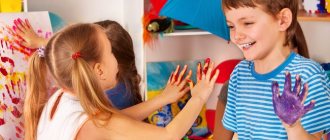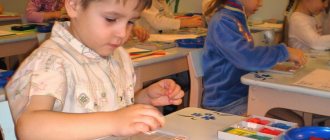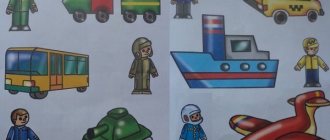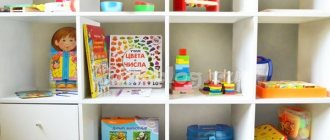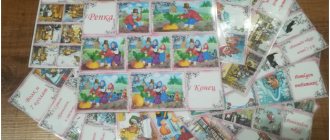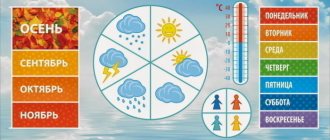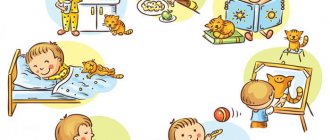The accumulated experience is not only about adults who are wise in life. A four-year-old child also has his own - albeit small, but noticeable compared to previous periods of development - life experience. At 4 years old, a child is still a baby, especially in the eyes of his parents: he talks funny, is surprised by new things and asks a lot of questions. But maturation is noticeable even in the appearance of a four-year-old. Childhood swelling smooths out, and the child begins to resemble a small adult.
If developmental norms for three-year-old children are more variable, then for four-year-olds these norms are already outlined quite clearly. Knowing what a 4-year-old child should be able to do, parents will be able to track and correct possible deviations.
Content:
- Basic knowledge and skills at 4 years old
- Norms of physical development Differences between boys and girls
- Weight and height
- Physical skills
- What if the child does not speak or speaks poorly?
Is there a mandatory standard?
All children are different and they develop differently. Therefore, there is no single standard regulating the skills and abilities of a young child.
The Federal State Educational Standard (federal state educational standard) determines the main directions of development of a 4-year-old child. They include basic everyday skills, physical activity, the ability to navigate the world around us, speaking skills, and understanding one’s gender role.
A neurologist monitors the baby’s development from birth. Therefore, parents need to periodically show their child to this specialist. The main function of a neurologist is to observe whether the child is developing correctly in order to identify possible deviations in time.
All the skills described above are not strictly necessary for four-year-old children. Each child develops at his own speed and may know and be able to do more or less than what is specified in the requirements.
Since the leading activity of preschool children is play, it is easier for them to master all new knowledge and skills in a playful form. The task of parents is to find or come up with useful games for the baby.
Basic knowledge and skills at 4 years old
What a child should be able to do at four years old - basic knowledge and skills:
- good control of your body: confidently move and navigate in space;
- be able to count to five and know what numbers up to five look like;
- it is enough to speak well: speech should become clearer compared to the age of three;
- possess self-service skills;
- understand some social norms: for example, distinguish good actions from bad ones.
Norms of physical development
Between three and four years of age, a child does not grow as quickly as at an earlier age. But the acquired physical and motor skills are sharpened, and new ones appear. At the age of four, differences in the physical abilities of boys and girls become noticeable.
Differences between boys and girls
Although the weight and height of four-year-old children of different sexes are still the same on average, the difference in physical development is already clearly visible:
- Boys at 4 years old run faster, outperform their peers in outdoor games, and learn to ride a bicycle well earlier.
- Girls at the age of four are ahead of their peers in intellectual development: they construct complex sentences, solve logical problems correctly, and easily memorize poetry.
Researchers who studied the thinking characteristics of preschool children found that this difference in development between boys and girls is associated with the structure of the brain. Four-year-old girls have a well-developed left hemisphere of the brain, which is responsible for developed intelligence and fluent speech.
With age, intellectual differences between children of different sexes are erased, and physical differences become even more noticeable.
Weight and height
The average height of children at four years old is 102-103 centimeters. Average weight - 16-18 kilograms. There may be deviations up or down from the average height and weight, depending on hereditary factors and the lifestyle of a particular child.
If your baby's height at 4 years is less than 94 centimeters, or he weighs less than 12 or more than 25 kilograms, it may be worth changing his daily routine and diet after consulting a pediatrician.
The norm of weight and height specifically for your son or daughter can be calculated as follows: in the interval between three and four years, the child should grow by 6-7 centimeters, and the weight should increase by 1-3 kilograms.
Physical skills
Physical skills that most 4-year-olds master:
- confidently handle a tricycle or scooter;
- eat completely independently, using cutlery deftly and as intended;
- know how to handle small parts of objects: correctly form multi-level pyramids, assemble construction sets and puzzles according to instructions or with the help of an adult.
Motor skills
The coordination of a four-year-old child is developing better and better, acquired motor skills are consolidated and new ones appear:
- knows how to jump high and far, knows how to somersault;
- tries to hit the target with the ball, catches and holds the ball with both hands;
- standing on one leg, maintains balance for at least 10 seconds, makes several jumps on one leg;
- becomes quite flexible, easily tilting the body from a standing or sitting position, for example, in order to put on shoes;
- can walk on tiptoes;
- Dresses and undresses without adult help, or with little help if you need to cope with a difficult fastener or laces.
Fine motor skills
The development of a baby’s speech and the correct development of thinking and memory depend on well-developed fine motor skills. It’s good if by the age of four the child has the following fine motor skills:
- colors pictures without going beyond the outline;
- tries to keep the pencil straight when drawing dots, does not lift his hand from the sheet of paper;
- traces samples and stencils with a pencil;
- launches the spinning top;
- folds his fingers, showing shapes, for example, “flashlight”;
- laces his own shoes or at least tries to manage the laces;
- strings buttons or beads with large holes onto a thread;
- Cuts out paper shapes with scissors fairly smoothly.
If your child does not yet master each of these skills, it is easy to help him: together learn to tie shoelaces, play with beads, show how to make finger figures.
LiveInternetLiveInternet
nata_tursha
all posts by the author
Development of children from 4 to 5 years old. A guide to materials from the “Child Development” site.
Children from 4 to 5 years old
Development of Children from 4 years to 5 years.
In this section, we will help you find out and determine the level of development of your child, namely, what your child should know and be able to do between the ages of 4 and 5 years. What should a 4 year old child know and be able to do? This article is intended for your information and gives approximate norms for the degree of formation of your child’s mental processes at this age. You can check his potential in different areas of knowledge, find out in which areas of knowledge your child succeeds, and in which additional attention and time are required. In this section “Children from 4 to 5 years old” we have collected all the material published on our website that will help you and your child study and prepare for the next, more in-depth stage of classes. You can use the materials for your classes at home, in kindergarten or in primary school. Mathematics
A child aged 4 to 5 years should be able to:
1. The child must be able to determine the location of objects: right, left, middle, top, bottom, back, front. 2. The child must know the basic geometric shapes (circle, oval, square, triangle and rectangle) 3. The child must know all the numbers (0, 1, 2, 3, 4, 5, 6, 7, 8, 9). Count objects within ten, correlate the number of objects with the desired number. 4. The child must be able to place numbers from 1 to 5 in the correct sequence and in reverse order. 5. The child must be able to compare the number of objects, understand the meaning: more - less, equally. Make unequal groups of items equal: add one item to a group with fewer items. 6. The child becomes familiar with the graphic image of numbers and learns to write numbers correctly.
Aids for classes:
1. Cards Teaching a child to count 2. Connect the numbers and color the picture 3. Game learning geometric shapes 4. Introducing the child to Geometric shapes 5. Cards with numbers from 0 to 10 6. Cards “which number is the odd one out” 7. Game for studying Geometric shapes 8. Writing Numbers 9. Numbers in words 10. Cards with Numbers-coloring 11. Puzzles-triple geometric shapes 12. Puzzles-triple Numbers and Counting 13. Geometric shapes.
Developing memory 14. Geometric shapes. Developing fine motor skills 15. Studying Geometric Shapes 16. Copybook in Mathematics 17. Learning to Count. Workbook 18. Learning to write Numbers from 1-9 19. Mathematical examples for preschoolers 20. Games with Geometric Shapes 21. Developing memory with Geometric Shapes 22. We correlate the quantity with the number 23. Entertaining tasks in mathematics 24. Orientation in space. Before and After 25. Cards with Numbers 26. Puzzle Counting from 1 to 10 27. Mathematics with Dice 28. Didactic games in mathematics 29. Puzzle Counting from 1 to 10 30. Mathematics with Dice for Children Logical Thinking - Development of Thinking , Memory, Attention
A child aged 4 to 5 years should be able to:
1. The child must be able to find differences and similarities between two pictures (or between two toys). 2. The child must be able to build according to the model of a building from a construction set. 3. The child must be able to put together a cut picture from 2-4 parts. 4. The child must be able to complete a task within 5 minutes without being distracted. 5. The child must be able to fold a pyramid (cups, placing them inside each other) without outside help. 6. The child should be able to put missing fragments of pictures into the holes. 7. The child should be able to name a group of objects with a general word (cow, horse, goat - domestic animals; winter, summer, spring - seasons). Find the extra item in each group. Find a pair for each item. 8. The child should be able to answer questions such as: Is it possible to sled in the summer? Why? Why do people wear warm jackets in winter? Why are windows and doors needed in a house? Etc. 9. The child should be able to select opposite words: a glass is full - a glass is empty, a tall tree - a low tree, walk slowly - walk quickly, a narrow belt - a wide belt, a hungry child - a well-fed child, cold tea - hot tea, etc. 10. The child should be able to remember pairs of words after reading them to an adult: glass-water, girl-boy, dog-cat, etc. 11. The child must be able to see incorrectly depicted objects in the picture, explain what is wrong and why.
Aids for classes:
1. Cards from the series find the extra object 2. Cards from the series find the extra object.
Part 2 3. Cards from the find the pair series 4. Find the shadow of the picture 5. Developing Logical Thinking 6. Big-Small Cards 7. Puzzles 8. Krasnoukhov's Puzzle 9. Logical Coloring Pages 10. Development of Attention 11. Development of Thinking 12. Development of Memory 13 Development of Memory.Part 2 14. Pick up a patch 15. Add the missing item 16. Game of opposites (Antonyms) 17. Entertaining activities with a child 18. Orientation in space. Right and Left 19. Game - “What is What?” 20. Game Catch a Fish 21. Game of Associations: Find a Pair 22. Game for the Development of Memory and Attention 23. Coloring magazine for children about Horses 24. Guess Whose Shadow Development of Speech
A child aged 4 to 5 years should be able to:
1. The child must use a thousand words, build phrases of 6-8 words. Even strangers, not just parents, should understand the child. 2. The child must understand how the human structure differs from the structure of animals, name their body parts (hands - paws, nails - claws, hair - fur). 3. The child must be able to correctly put nouns into the plural form (flower - flowers, girl - girls). 4. The child must be able to find an object according to its description (apple - round, sweet, yellow). Be able to independently write a description of an item. 5. The child must understand the meaning of prepositions (in, on, under, behind, between, before, about, etc.). 6. The child should know what professions there are and what people in these professions do. 7. The child must be able to maintain a conversation: be able to answer questions and ask them correctly. 8. The child must be able to retell the content of a fairy tale or story he has heard. Recite a few poems and nursery rhymes by heart. 9. The child must state his first and last name, how old he is, and name the city in which he lives. 10. The child should be able to answer questions regarding recent events: Where were you today? Who did you meet along the way? What did mom buy at the store? What were you wearing?
Teaching aids:
1. Letters of the Alphabet-Puzzles 2. Studying the letter A. What the letter A looks like. 3. Studying vowels 4. The alphabet in the form of cards 5. How to teach a child to read syllables 6. Learning to Read. Part 1 7. Learning to Read. Part 2 8. Learning to Read.
Part 3 9. Colored Letters of the Alphabet 10. Unique Alphabet by Letter 11. Lotto study Letters 12. Cards with Letters and Pictures 13. Pure Sayers 14. Counting Counters and Counting Counting Tables 15. Play and learn to read Syllables 16. Collect a Word from the Picture and Letters 17. Cards - What Letter does the Word Start with 18. Collect the Word from the Picture and Letters. Didactic Game The world around us
A child aged 4 to 5 years should be able to:
1. The child must be able to distinguish between vegetables, fruits and berries, and know what they are like when they ripen. 2. The child must know the names of insects, be able to talk about how they move (a butterfly flies, a snail crawls, a grasshopper jumps) 3. The child must know all domestic animals and their babies. 4. The child should be able to guess the seasons from pictures. Know the signs of each of them.
Aids for classes:
1. Cards Parts of the human body 2. Cards depicting Transport 3. Cards with Fruits 4. Cards with Vegetables 5. Cards learning Colors 6. Cards Furniture 7. Cards “animals and what they eat” 8. Cards “Clothing” and Shoes" 9. Cards Animals and Birds 10. Cards Professions 11. Structure of Tree and Leaves 12. Season Autumn 13. Season Winter 14. Season Spring 15. Season Summer 16. Cards learning Colors 17. Winter month - December 18. Winter month - January 19. Winter month - February 20. Classes on the topic Winter 21. Fruits and berries. Study and color 22. Vegetables. We study and color 23. Fruits and Berries (coloring cards) 24. Vegetables (coloring cards) 25. The month of spring - March
26. Spring month - April
27. Spring month - May 28. Unique books - Seasons 29. Summer month - June 30. Summer month - July
31. Summer month - August 32. Autumn months - September 33. Autumn months - October 34. Autumn months - November 35. Cards Electrical household appliances 36. About professions for children 37. My home.
Components of a house. 38. Cards Insects 39. Crockery and Cutlery 40. The world around us 41. Cards Game “What for What” 42. Cards Insects 2. 43. Cards Professions. Part 2 44. Cards Flowers 45. Cards Seasons and Natural Phenomena 46. Educational Games with Clothespins Household Skills
A child aged 4 to 5 years should be able to:
1. The child is already excellent at buttoning buttons, zippers and untying shoelaces; he can handle a spoon and fork well. 2. The child must be able to string large buttons or beads onto a thread. 3. The child must be able to accurately draw lines without lifting the pencil from the paper. 4. The child should be able to shade figures with even, straight lines, without going beyond the contours of the drawing. 5. The child must be able to trace and color pictures without going beyond the edges. 6. The child should be able to draw lines in the middle of the path without going beyond its edges. 7. The child must distinguish between the right and left hand.
Aids for classes:
1. Stencils for drawing 2. How to teach a child to tie shoelaces 3. Trace and color 4. Tic-tac-toe game in a new way 5. Signs and Properties of objects 6. Flowers applique 7. Getting to know the concepts: Right, left , above, below 8. Studying the Clock 9. Book My Home 10. Parts of the Human Body 11. Copybook for Left Handers 12. Game Catch a Fish 13. Bus for Little Ponies 14. Game - all Professions 15. My Home.
Components of a house. 16. Plasticine and beads 17. Board Game Tell us about your city 18. Children's Counting Books 19. Caterpillar made of Colored Cardboard 20. Learning colors with the help of Ice Cream 21. Applications from Buttons 22. DIY Christmas tree from Shishka 23. Cheerful Chupa-Chups 24. Learning Days of the Week English
A child between the ages of 4 and 5 can be introduced to the English language. Use manuals for parents and teachers for teaching English to children aged 4 to 5 years.
Aids for classes:
1. English Letter Puzzles 2. Cards with Letters of the English Alphabet 3. Number cards in English 4. Cards Fruits and Berries 5. Cards with English words. Part 1 6. Cards with English words. Part 2 7. Cards Furniture in English 8. Cards Electrical appliances 9. Cards Clothes 10. Cards Vegetables in English 11. Cards Months in English 12. Cards Transport in English 13. Puzzles Large and Small letters of the English alphabet
Sensory development and dental care
vision almost as as that of adults. Four-year-olds are rarely ready to read, but you can already introduce letters to your child. The main thing is to choose books, cards and other aids where the letters are printed in large font - this way the child’s vision will not be too strained.
hearing is already fully formed. The sense of smell is improved : the child feels and identifies complex odors. The skin remains sensitive to cold; the baby feels warmth in the same way as adults. Children aged four years feel the taste of food almost like adults, but with a slight difference: in a multi-component dish, the child mainly distinguishes the main component, poorly recognizing the nuances of taste of the remaining components.
Four-year-old children already have 16-20 baby teeth . Due to the fact that baby teeth are much more vulnerable than permanent teeth, you need to carefully monitor your child’s oral hygiene: teach your child to brush his teeth regularly and treat problem teeth in a timely manner. Keeping baby teeth healthy is very important: baby teeth removed early can cause improper jaw formation and lead to other problems. Thus, children who have lost their baby teeth early may have distorted facial features.
Logical thinking
At the age of four, visual-effective thinking is complemented by visual-figurative thinking. The baby learns the properties of objects not only by interacting with them, he can already think about them and draw appropriate conclusions.
At four years old, children should be able to:
- find an extra object in a group of similar ones;
- find differences in similar pictures;
- understand what elements are missing in the picture;
- come up with a logical end to a given storyline;
- find a way out of the drawn labyrinth;
- guess an object or animal from a verbal description.
In children, logical thinking develops naturally, from interaction with the world around them. But it can be improved if you work with your baby and play logic games - board and word games.
Speech of a child at 4 years old
The passive vocabulary of a 4-year-old child is 3,000 words: this includes those words that the baby actively uses in speech, and those whose meaning he knows, but rarely uses in speech. Passive vocabulary includes, for example, outdated words that are often found in fairy tales: plow, upper room, stupa and the like.
A four-year-old’s active vocabulary includes as many words as he needs to communicate with others—usually about 1,000 words.
What if the child does not speak or speaks poorly?
A child at the age of four can coherently tell how the day went, uses sentences of eight words or longer in speech, and clearly describes the objects he saw.
Speech development in four-year-old children may differ - girls usually speak quickly, while boys find it more difficult to find the right words. But if the child does not speak at all or severely distorts words, you should consult a pediatrician.
The absence of coherent speech at 4 years old may indicate delayed mental development, hearing problems, and severe stress. A pediatric neurologist, otolaryngologist and speech therapist will help parents understand the reason for the child’s silence.
Second language learning
Courses for studying English or another foreign language suggest starting to learn a second language at the age of four. At this age, children easily remember foreign names of objects and phenomena and are not shy about making mistakes.
But it is advisable that the child already has a fairly good command of Russian speech before starting to learn a second language - otherwise serious problems with the pronunciation of foreign words are inevitable, which will be difficult to correct later.
The best seven iOS games for iPad
Weather MarcoPolo
With this colorful application, your child will become familiar with various weather phenomena. Control of temperature, rain, wind, rainbow, valuable tips for parents on playing together with their baby, high-quality voice acting and animation - all this makes the application a very useful and exciting toy. It can be used in exercises to develop speech and logical thinking.
PepiBath
This application will become your faithful assistant in teaching your child hygiene skills. You can choose a boy or a girl as your hero. Together with them, the baby will learn to blow his nose, brush his teeth correctly, cut his nails and wash his hands on time.
TocaBand
If your child loves music, then he will really like this application. It is very easy to use and opens up wide possibilities for creating your own melodies. Funny musicians can be used to form any orchestra that will perform a very pleasant and rhythmic piece, written taking into account the rules of musical literacy.
LittleFoxMusicBox
Little Fox's Music Box features amazingly beautiful animation by Heidi Wittlinger (an Oscar-nominated animator, by the way). This is not just a music application, but a real recording studio with which the child can create his own melodies. In addition, the application includes three animated interactive clips of English folk children's songs.
Application for children
This is the simple name for a set of colorful puzzles of varying complexity. The riddle pictures are made in the style of Japanese cartoons and have simple funny plots that are understandable and close to a child. The application is perfect for developing logical thinking and visual memory.
Socialization: communication, emotions
At 4 years old, the child knows and accepts the norms of behavior in society. In communicating with peers, a four-year-old learns to share, play his role in the game, and recognize good and bad deeds. The child increasingly strives to communicate with peers, gradually separating from his parents. True, there are exceptions: when the baby does not want to play with other children and is more interested in spending time alone. This behavior is a variant of the norm and indicates the child’s character traits.
When communicating with adults, a well-socialized 4-year-old child follows the rules of etiquette: addresses himself as “you” and by his first name and patronymic, and follows the rules of behavior in kindergarten or other institutions. By the age of four, a child should know that he can only trust familiar adults, and that he should not talk to strangers or go somewhere.
The range of emotions of four-year-old children is quite wide: they are able to recognize the emotions of other people, restrain their own emotions, and actively use facial expressions and gestures to express feelings.
A four-year-old needs his own space - this could be a separate room or a play corner - where he feels like he is the master. A child may perceive an invasion of personal space without permission, even from close people, as painful.
conclusions
So, 4 years is a period of discovery, both for the baby and for his parents. A four-year-old child actively learns about himself and the world, his abilities and talents manifest themselves. The skills acquired earlier continue to be improved. The child’s intensive physical, mental and personal development occurs: the baby learns to control his body and emotions, memory, attention, thinking, speech and imagination develop. Four-year-olds simply need to communicate with their peers, because the development of children occurs mainly in role-playing games.
Psychological condition
Four-year-old children do not feel fear well - the task of parents is to tell their son or daughter about possible dangers: about potentially dangerous household appliances, about stray animals, about walking alone.
Normally, a psychologically developed child at the age of four should:
- take into account the assessment of your behavior by significant adults: parents, educators;
- be as independent as possible;
- be able to serve yourself in accordance with your age.
Cognitive development
At 4 years old, the baby strives to do a lot on his own, thanks to which his cognitive abilities develop intensively. The abilities of children attending a kindergarten or other preschool institution usually develop a little faster than those of children at home - communication with peers and regular classes with teachers have a positive effect on the formation of basic cognitive abilities: memory, attention, thinking.
Mental development
By the age of four, children can already do a lot. Children who go to kindergarten or attend enrichment classes usually have more intellectual skills than their peers sitting at home.
A four year old child should be able to:
- concentrate on the current activity for 7 minutes;
- know your full name, surname and patronymic, as well as the names of family members and home address;
- remember the way from home to kindergarten or other place where he often goes with adults;
- remember and be able to retell recently occurring events;
- collect puzzles with large elements;
- good orientation in space, distinguish between right, left, top, bottom;
- remember the main plot line of a fairy tale or story;
- compare objects by shape, size, color;
- know the time of day, seasons, be able to tell how they differ from each other;
- know the names of animals, objects, clothing items, etc.;
- perform simple tasks according to the model;
- color the pictures.
The development of memory, thinking, and attention directly depends on how much adults work with the baby. At this age, imaginative thinking predominates in children, and memory is directly related to emotions: the baby best remembers events that are emotionally significant for him.
Everyday skills
Four-year-old children can partially take care of themselves: dress and undress, carefully use the toilet, wash and brush their teeth. They are well oriented in their home, they know where specific things should be.
At 4 years old, the child himself strives to master new skills, and parents can teach him new skills in everyday life:
- to make one's bed;
- take dirty clothes to the laundry;
- keep order in a small area of the house, for example, in the bathroom.
Self-care skills
The foundations of self-care skills are laid at the age of three. By the age of four, children can already perform basic household activities independently, without the help of adults.
The child must be able to:
- brush your teeth, rinse your mouth;
- wash, wash hands, dry with a towel;
- take a shower;
- go to the toilet independently;
- blow your nose into a handkerchief and wipe your nose and mouth;
- use a comb;
- fasten and unfasten buttons, zippers, Velcro;
- putting on and taking off clothes and shoes;
- use cutlery (spoon, fork, mug);
- know where different things are (toiletries, dishes, clothes);
- understand what things can be taken and what cannot;
- put away toys, fold clothes.
Some children at this age enjoy learning more complex household skills - sweeping the floor, dusting, washing dishes. The more adults encourage such activities (naturally, controlling their implementation), the faster the baby develops in everyday life.
Daily routine and child care
An approximate daily routine for a four-year-old child:
| 07.00 | Getting up, hygiene |
| 08.00 | Breakfast |
| 09.00 | Quiet games, educational activities |
| 10.00 | Walk |
| 12.00 | Dinner |
| 13.00 | Daytime nap |
| 15.00 | Afternoon snack |
| 16.00 | Active games or a walk |
| 18.00 | Dinner |
| 19.00 | Communication with family, developmental activities |
| 20.30 | Hygiene |
| 21.00 | Going to bed |
⠀ If a child does not attend kindergarten, at 4 years old he can refuse naps.
Four-year-olds need certain care from adults:
- remind your child of the importance of personal hygiene;
- walk longer in good weather;
- include hardening procedures in your daily routine: air and sun baths, rubdowns.
The world
Children aged 4 years are actively exploring the world around them. The task of parents is to help them in every possible way in this, replenishing their knowledge base. A 4 year old child should know the following:
- names and purposes of basic household items (dishes, refrigerator, TV);
- several names of trees and flowers;
- names of all parts of the human and animal body and understanding of the differences in the structure of the human body from the body of an animal (hands, paws, nails, claws);
- understand that people and animals, in addition to external organs, also have internal ones, know the names of some of them (heart, brain);
- be able to name and simply describe several professions (driver, doctor), know what parents do;
- distinguish between different types of transport;
- know the names of food products, be able to describe their taste (sweet, salty);
- distinguish the materials from which objects are made (wood, metal, paper);
- be able to name individual parts of an object (cup handle, table leg);
- know your age, city and country of residence;
- understand the main family ties (grandmother is mother’s mother, etc.).
This is the minimum set of knowledge that a four-year-old child should have. Children of this age can know much more. In kindergarten, they study weather phenomena, activities characteristic of different seasons (autumn - harvesting, etc.), the habits of animals and birds, and seasonal holidays.
Four-year-old children already clearly understand their gender roles. Boys know that they are future men, and girls know that they are women. Accordingly, the former begin to be interested in men's activities, and the latter - in women's.
When should you worry about your child's development?
Features of a child that at the age of four may indicate developmental delay:
- cannot concentrate on one activity even for a few minutes;
- does not control emotions, outbursts of aggression occur;
- does not play with toys and is not interested in them;
- does not use complex sentences in speech, generally has difficulty expressing thoughts orally;
- too mobile or, conversely, very slow.
If you notice such symptoms in a child, consult your local pediatrician.
English language
At preschool age, you can already start learning a foreign language. Kids easily remember words and do not have a psychological barrier that makes it difficult to pronounce the sounds of unfamiliar speech. Therefore, many parents take their children to English courses for preschoolers.
The main difficulty teachers of foreign languages for children face is the difficulty of pronunciation. Not all children even pronounce Russian words correctly, let alone English ones. Another problem is that children often confuse the words of their native and foreign languages.
Children aged four years learning English know the names of various household objects, animals, and primary colors. They are also familiar with the words “mom”, “dad”, “grandfather”, “grandmother”, “brother”, “sister”.
How to help a child's development?
Activities that will help a 4-year-old child develop correctly:
- Simple physical and chemical experiments. For example, with water freezing in the cold, with mixing settled water with ink.
- Learning new mathematical concepts: “equal”, “wide-narrow”, “low-high”.
- Reading children's books, retelling their fragments. Retellings can begin with one paragraph; over time, the child will be able to retell a whole chapter.
- Applications and modeling.
- Age appropriate sports: skiing, swimming, running.
Games
Games for developing memory, attention and thinking of four-year-old children:
- Any role-playing games that allow children to use their imagination and imagine themselves in a new role. Such games can be improvised or organized: children can play classic “daughter-mother” games themselves or, under the guidance of an adult, play according to a pre-thought-out plot, for example, “One Day at School” or “At a Doctor’s Appointment.”
- Games to develop emotional intelligence. Ask your child to emotionally depict different moods: show a very tired person, a gloomy cloud, a smiling sun.
- The game “Come up with another name” perfectly develops children's imagination. Invite your child to come up with other names for common objects: a spoon is a “porridge scooper,” boots are “armor against dirt,” rags for wiping dust are “a weapon for cleaning.”
- Age-appropriate didactic games: sorters, puzzles, educational cards.
- Drawing blindly. The child draws without opening his eyes, and then comes up with what the resulting confusion could mean.
Despite noticeable maturation, the main activity for a four-year-old child remains playing. Try to include playful moments in different life situations - even the process of dressing can be framed as a fun game. Without feeling pressure and demands, your child will develop on time and at a pace that is comfortable for him!
Top 8 Android Apps
SagoMini Trains
The app will take your child on an exciting train ride through one of three locations - a city, a magical forest or a winter fairy tale. Along the way, the driver needs to pick up cargo and passengers. This is a great option for a long journey, since the game does not require an Internet connection.
Animal doctor
The application is a high-quality simulator of the work of a veterinarian. During the game, the child will learn to take care of pets and learn how to help a pet during illness. The app has nice animations and contains a lot of interesting information about health and hygiene, presented in simple language.
Fixies: Masters on a helicopter!
Favorite characters will help your child solve many interesting puzzles that develop logical thinking, memory, and the ability to synthesize and analyze information. The child’s task is to quickly fix various breakdowns throughout the city, and this is where a helicopter is needed.
Learning to Read in English. Preschool education
The application is built on the principles laid down by Maria Montessori. It is based on a plot about animals bewitched by an evil sorceress who need to be saved. The words are voiced by native speakers, thanks to which the child will hear the letter exactly as it sounds in a particular word. The game has 16 levels of varying difficulty. Training goes from simple to complex.
Dinobum
The application includes 20 educational puzzles of varying complexity to develop logic and thinking. Compare dinosaur figures, assemble puzzles, find a suitable shadow - these and other tasks will help your child learn to classify and organize objects according to different criteria.
